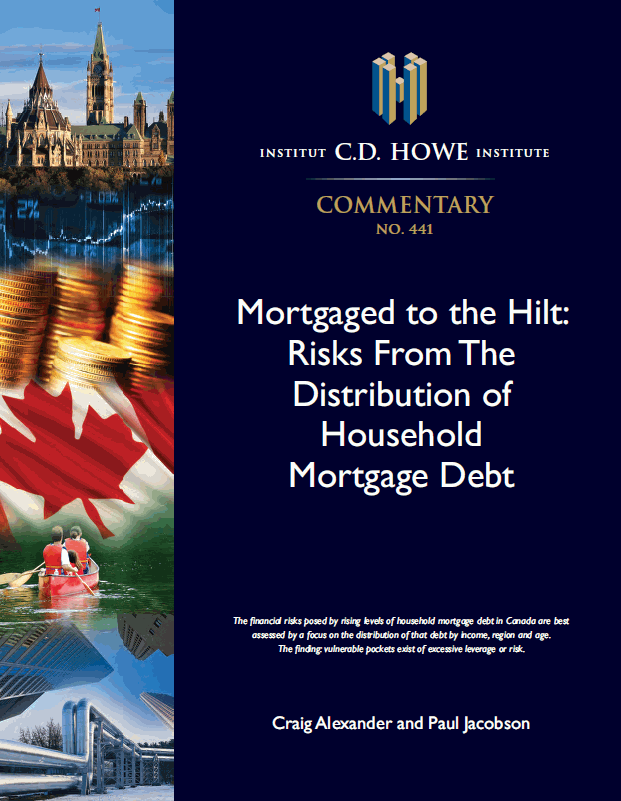 The “sustained low interest-rate environment” has caused a “significant minority” of Canadians to take on more mortgage debt than they can comfortably manage. That was the conclusion from a recent study by C.D. Howe.
The “sustained low interest-rate environment” has caused a “significant minority” of Canadians to take on more mortgage debt than they can comfortably manage. That was the conclusion from a recent study by C.D. Howe.
Out of all the study’s findings, the one garnering the most headlines was the percentage of homeowners with a mortgage debt-to-disposable income ratio in excess of 500%. That number has rocketed from 3% in 1999 to 11% in 2012 (the latest data available). That’s upwards of half a million households.
That led the study authors, Craig Alexander and Paul Jacobson, to suggest that the federal government “may want to consider further policy actions to lean against the shift towards significantly higher mortgage burdens.” This is despite their conclusion that “the majority of Canadians have been responsible in their borrowing.”
Coincidentally, this study came out right before the Finance Department raised minimum down payments. That measure addressed some of Alexander and Jacobson’s concerns, but not all. They note that highly mortgage-indebted households are more likely to be
- in the lower-income quintiles
- i.e., not buying the $500,000+ homes targeted by the new down payment rules
- younger Canadians who have recently entered the housing market
- the average first-time buyer’s purchase price is $293,000, says the DoF, again, less than $500,000
- from provinces with the biggest housing booms.
Also concerning is the fact that roughly 1 in 5 mortgage-indebted households have less than $5,000 in financial assets to draw upon if they lose their job or face surging interest rates. Worse yet, 1 in 10 have less than $1,500 in financial assets and are considered “extremely vulnerable to a negative economic or financial shock.”
“This represents an inadequate financial buffer,” say the study’s authors, “as the Statistics Canada Survey of Household Spending indicates that average mortgage payments are more than $1,000 a month, before taxes and operating costs.”
All of this speaks to two risks. The first is obviously the financial risk to the borrowers themselves. Even if arrears rates stay contained as expected, no one wants families backed into a debt corner, doing things like racking up unsecured debt to finance secured debt.
The second risk is systemic (i.e., what happens to our financial system if default rates are higher than anticipated?). Default insurers claim they can withstand a U.S.-style housing sell-off without dipping into taxpayer pockets. (By the way, we are assuming/hoping that insurer’s stress tests rest on adequate assumptions.) But the mortgage market would nonetheless endure painful market volatility, huge risk premiums and illiquidity. These effects would be (will be) exacerbated if debt ratios continue moving in the wrong direction.
Hence, if home prices in T.V. (Toronto/Vancouver) continue climbing in 2016, the DoF may not be finished it’s policy tightening. Lowering maximum debt ratio guidelines and increasing minimum credit scores (especially for borrowers making small down payments) could get more attention in Ottawa.
But Alexander and Jacobson wisely recommend that any new mortgage rules be targeted. The last thing anyone wants are weak markets getting weaker with a national policy intended to rein in T.V. lending.
Moreover, given enough time, natural economic forces would address some of the imbalances we’re seeing, specifically
- higher prices would curtail demand
- higher rates would crimp affordability, and hence prices (best not hold your breath on this one)
- higher incomes would improve affordability and debt ratios (for many)
- housing supply would catch up with demand (maybe not in the major single-family urban markets, but definitely with multi-family units and suburban housing)
But policy-makers are likely not content to let the “invisible hand” correct household debt risks on its own. So keep an eye on this chart through the first half of 2016. It may have magically predictive properties for new mortgage rules.

Other notable findings from the survey:
- B.C. has gone from a primary mortgage-to-disposable income ratio of 250% in 1999 to 375% in 2012 (Remember that’s an average, so many are above this ratio)
- Ontario’s average mortgage-to-disposable income ratio rose from nearly 200% to around 350%
- The share of young households (age 25 to 34) with ratios above 300% has increased by almost 27 percentage points
- 14% of those aged 25 to 44 have ratios above 500%, along with 16% of those 65 to 75 years old vs. just 5% of those aged 45 to 54
Ultimately, debt service ratios (a.k.a., affordability ratios) are far more predictive of losses than debt-to-income ratios, and Canada’s average debt service ratio isn’t far from its long-run average. But we may never realize how close some people are to the edge until interest rates or unemployment spike.








Great article Rob. Speaking of the “invisible hand” I believe it was financier Henry Clews who wrote “the best cure for high prices is high prices” in 1918. The theory further postulates that if the government steps in and artificially lowers prices, supply is not increased (ie. there’s less incentive to build more houses) and demand is not decreased.
I’m pleased that you made mention of the supreme importance of debt service ratios over debt-income ratios, especially in light of the fact that interest rates have declined steadily for the past 35 years (http://www.ratehub.ca/prime-mortgage-rate-history). I note that in January of 1999, the starting point of the study in question, the prime rate was 6.75%.
It must also be remembered that a spike in interest rates and / or unemployment is always a shock to the economy and a financial blow to almost everyone, especially the most vulnerable, regardless of prevailing interest rates.
Thanks Appraiser, On the supply side, Will Dunning makes a similar valid point, “The greatest pressures are in the communities with inadequate supply, which is now widely acknowledged, including in the Finance Minister’s fiscal update statement. Suppressing demand will not address the issue…”
The problem with the “debt service ratio” is that is has nothing to do with the absolute level of debt taken out by Canadians. It is a foolish ratio to use, since it is the absolute level of debt which creates the risk, not the temporary ability or inability to make payments at a particular interest rate. The Canadian economy has not simply become dependant on low interest rates, it has become dependant on *dropping* interest rates. In other words, the rate floor will create a price ceiling for houses. To go beyond this ceiling, Canadians will need to experience wage inflation. Wage inflation has nowhere kept up with house price growth. Our phony economy has been propped up for the past 35 years by steadily dropping rates (that’s right – its not low interest rates that keep us going, but dropping interest rates). The Canadian economy (which has become significantly dependant on phony housing price growth) will begin to seize, once we hit the rate floor at the next crisis. We’re repeating all the mistakes of the past on a larger scale. What happens when the 10% YOY gains stop? What happens when the banks stop approving larger HELOC loans? Where will the Canadian economy go, when manufacturing, commodities and finally the housing market start to flatline?
On the contrary, it is foolish not to use the debt service ratio. Absolute debt is not what bankrupts people. Inability to service debt is what bankrupts people. That is why lenders build in a buffer for future rate increases when qualifying borrowers.
While the housing market needs to be cooled a bit I don’t see the government doing much in case they get blamed for a crash. This is evident by the new down payment rules which was nothing more than a political move.